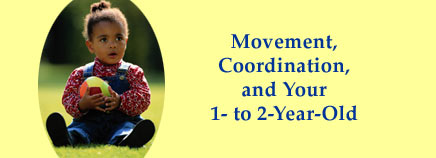
Walking is the major achievement of kids this age and over the coming year they’ll get much better at it.
As kids’ mobility improves, so does their ability to investigate where they couldn’t before. Once again, take a look around your home from a kid’s vantage point and update childproofing measures to keep up with your child’s advancing skills.
How Is My Baby Moving?
Though some babies take their first steps before their first birthdays, most learn to walk well in the months after they turn 1.
Kids who are learning to walk are called “toddlers” because that’s exactly what they do — they toddle, keeping their legs wide apart and seeming to hesitate between each step, jerking from side to side as they move one foot forward, then the next.
About 6 months after taking their first steps, toddlers develop a more mature gait, holding their hands at their sides (rather than out in front for balance) and moving with their feet closer together. They also tend to move their feet in a way that looks more like walking — moving from the heel to the toe.
During these months of practice, most toddlers take a few spills, but this is part of learning to walk. You can’t protect your youngster from every fall, but you can reduce the risk of injury by keeping exploration in areas with soft carpeted surfaces and away from sharp corners of furniture.
To get back up from a fall, toddlers often place their hands out in front, lift up their bottom, and then pull their feet under. It may not look very graceful, but it works.
After walking for a couple of months, your child will begin to feel more confident about walking and take on new challenges — such as picking up and carrying objects, moving while pulling a toy behind, and climbing stairs.
By the middle of the second year, your child may learn to run, start to kick a ball, and even attempt to throw a ball. By 2 years, your child may jump in place.
As kids develop the ability to move, they’re also learning. You’ll notice that your child seems extremely interested in finding out how things work, so offer safe opportunities to do this.
Helping Your Child’s Development
Give your child lots of things to do and see in this new upright position. Take walks around your yard or through the neighborhood together or hold hands and climb up and down the stairs together. You can even make an obstacle course of pillows or boxes and encourage your child to walk, climb, and crawl through it. Buy a few balls for kicking and throwing.
Experts recommend that toddlers should:
- get at least 30 minutes daily of structured (adult-led) physical activity like playing on the playground, going for a walk, or being in a parent-and-child tumbling class
- also have at least 1 hour of unstructured free play each day when they can explore and play with toys
- not be inactive for more than 1 hour at a time except when sleeping
- have indoor and outdoor areas that meet or exceed recommended safety standards for all of their activities
As their physical skills develop, toddlers also learn to use their hands more. Toys and objects that can encourage this include:
- paper and crayons
- sculpting dough
- simple stacking toys that kids can build up and knock down
- simple puzzles
When to Call the Doctor
Normal child development tends to follow a certain pattern. The skills that babies develop early serve as building blocks for future skills. Still, the time it takes to develop these skills can vary widely among kids.
Your doctor will talk to you during routine check-ups about your child’s progress. But if you have concerns before then, call your doctor, especially if your child does not:
- walk by 18 months
- walk in a more mature pattern after several months of practice
- walk any way but on the toes
- climb stairs while holding on

